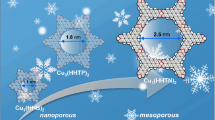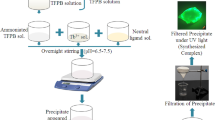Abstract
The reaction of Cd(NO3)2⋅4H2O with 3-aminoquinoline (3-Аq) affords the molecular and poly-meric complexes [Cd(NO3)2(H2O)(3-Аq)]⋅2MeCN (I) and {[Cd(NO3)2(3-Аq)2]⋅MeCN}n (II), respectively, depending on the ratio of the reagents and composition of the medium. Compounds I and II are studied by elemental analysis, X-ray structure analysis (CIF files CCDC nos. 2015059 (I) and 2015060 (II)), X-ray diffraction analysis, and luminescence investigation. In both cases, the environment of the cadmium atom is a pentagonal bipyramid. The 3-Аq molecules of dimer I are bridging ligands, and the monodentate mode of binding with Cd(II) along with the indicated function is observed in the polymer. Hydrogen bonds between the H atoms of the NH2 group and the N atom of the solvate MeCN molecule and the O atom of the NO3 group result in the formation of a three-dimensional supramolecular network, which is additionally strengthened by intermolecular stacking interactions between the aromatic fragments of 3-Аq of the adjacent molecules. Both compounds luminesce in the red spectral range. As compared to the spectrum of free 3-Аq, the shift of the emission bands of dimer I and polymer II in this range is 93 and 38 nm, respectively.



Similar content being viewed by others
REFERENCES
Gao, S., Fan, R.Q., Wang, M., et al., RSA Advances, 2015, vol. 5, no. 54, p. 43705.
Mirzaei, M., Eshtiagh-Hosseini, H., Bolouri, Z., et al., Cryst. Growth. Des., 2015, vol. 15, no. 3, p. 1351.
Pairu, M.K., Dinda, J., and Lu, T.-H., Polyhedron, 2007, vol. 26, p. 4131.
Azam, M., Al-Resayes, S.I., Pallepogu, R., et al., J. Saudi Chem. Soc., 2016, vol. 20, p. 120.
Azam, M., Al-Resayes, S.I., and Pallepogu, R., Helv. Chim. Acta, 2016, vol. 99, p. 20.
Nather, C., Jess, I., Germann, L.S., et al., Eur. J. Inorg. Chem., 2017, p. 1245.
Kovalev, V.V., Kokunov, Yu.V., Voronina, Yu.K., et al., Russ. J. Coord. Chem., 2020, vol. 46, no. 6, p. 420. https://doi.org/10.1134/S1070328420060032
SMART (control) and SAINT (integration). Software. Version 5.0, Madison: Bruker AXS Inc., 1997.
Krause, L., Herbst-Irmer, R., Sheldrick, G.M., and Stalke, D., J. Appl. Crystallogr., 2015, vol. 48, p. 3.
Sheldrick, G.M., Acta Crystallogr., Sect. A: Found. Crystallogr., 2008, vol. 64, p. 112.
Niu, C., Wan, X., Zheng, X., et al., J. Coord. Chem., 2008, vol. 61, p. 1997.
Bai, Y., Gao, H., Dang, D.-B., et al., Synth. React. Inorg. Met.-Org. Nano-Met. Chem., 2009, vol. 39, p. 518.
Xu, H., Xue, C., and Huang, R.-Y., Synth. React. Inorg. Met.-Org. Nano-Met. Chem, 2015, vol. 45, p. 1565.
ACKNOWLEDGMENTS
The compounds were synthesized and studied in the framework of the state assignment of the Kurnakov Institute of General and Inorganic Chemistry (Russian Academy of Sciences) in the area of basic research. The X-ray structure analysis of single crystals, X-ray diffraction analysis, luminescence studies, and elemental analysis were carried out using the equipment of the Center for Collective Use “Physical Methods of Investigation” at the Kurnakov Institute of General and Inorganic Chemistry (Russian Academy of Sciences) in terms of the state assignment of the Kurnakov Institute of General and Inorganic Chemistry (Russian Academy of Sciences) in the area of basic research.
Funding
This work was carried out in the framework of the state assignment of the Kurnakov Institute of General and Inorganic Chemistry (Russian Academy of Sciences) in the area of basic research.
Author information
Authors and Affiliations
Corresponding author
Ethics declarations
The authors declare that they have no conflicts of interest.
Additional information
Translated by E. Yablonskaya
Supplementary Information
Rights and permissions
About this article
Cite this article
Kovalev, V.V., Kokunov, Y.V., Shmelev, M.A. et al. Molecular and Polymeric Cadmium Nitrate Complexes with Bridging 3-Aminoquinoline: Synthesis, Structures, and Luminescence Properties. Russ J Coord Chem 47, 272–279 (2021). https://doi.org/10.1134/S1070328421040047
Received:
Revised:
Accepted:
Published:
Issue Date:
DOI: https://doi.org/10.1134/S1070328421040047




